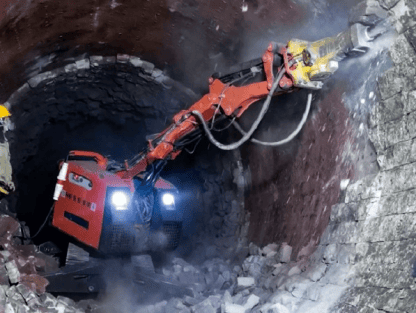Demolition is a critical process in industrial maintenance, particularly in industries that rely on rotary kilns for production, such as cement, metal refining, and chemical processing. Over time, rotary kilns require cleaning and maintenance due to wear and tear, with brick removal being one of the most essential yet challenging tasks. With advancements in technology, demolition robots have emerged as a game-changing solution for improving efficiency and safety during rotary kiln demolition. This article delves into the methodical use of demolition robots to enhance brick removal efficiency in a pellet kiln and explores their broader applications in rotary kiln cleaning and demolition.

Rotary kilns are large cylindrical structures used for material processing at high temperatures. Over time, the refractory bricks lining the interior of the kiln degrade due to exposure to extreme temperatures, chemical reactions, and physical stress. To maintain optimal kiln performance, these bricks must be periodically removed and replaced.
Traditional methods of rotary kiln demolition involve manual labor using hammers, chisels, and other handheld tools. While effective, these methods are time-consuming, labor-intensive, and pose significant safety risks to workers. Additionally, inefficient brick removal can lead to prolonged downtime, affecting production schedules and incurring financial losses.
The integration of demolition robots into rotary kiln cleaning and demolition processes has revolutionized how industries handle these challenges, offering a safer, faster, and more efficient alternative.
A demolition robot is a remotely controlled, compact machine designed to perform various demolition tasks, including breaking, cutting, and drilling. Equipped with advanced tools such as hydraulic hammers and chisels, demolition robots can handle heavy-duty operations with precision and efficiency. These machines are particularly advantageous in confined spaces like rotary kilns, where manual labor is limited by physical constraints and safety concerns.
Demolition robots are powered by electric or hydraulic systems and can be controlled remotely, allowing operators to work from a safe distance. This not only minimizes the risk of injury but also enables continuous operation without fatigue, thereby boosting productivity.
Precision and Speed
One of the primary advantages of using demolition robots in rotary kiln demolition is their precision. The robotic arm can be programmed to target specific areas, breaking down refractory bricks quickly and efficiently without damaging the kiln's structural integrity. This level of precision significantly reduces the time required for brick removal compared to manual methods.
Enhanced Safety
Rotary kilns are hazardous environments due to high residual temperatures, dust, and confined spaces. Demolition robots eliminate the need for workers to enter the kiln during the demolition process, reducing the risk of injuries caused by falling debris, heat exposure, and physical strain.
Versatility
Demolition robots are equipped with interchangeable tools, allowing them to perform various tasks such as breaking, cutting, and cleaning. This versatility makes them ideal for both brick removal and general rotary kiln cleaning, streamlining the maintenance process.
Continuous Operation
Unlike human workers, demolition robots do not require breaks and can operate continuously for extended periods. This uninterrupted operation significantly accelerates the brick removal process, reducing kiln downtime and improving overall efficiency.
Cost-Effectiveness
While the initial investment in a demolition robot may seem high, the long-term benefits outweigh the costs. Faster brick removal and reduced downtime translate to significant savings in labor and production losses. Additionally, the reduced risk of worker injuries lowers insurance and compensation expenses.
Inspection and Preparation
Before deploying a demolition robot, conduct a thorough inspection of the pellet kiln to identify areas requiring brick removal. Remove loose debris and ensure the kiln environment is stable for robotic operation.
Selection of Tools
Equip the demolition robot with the appropriate tools for the task. Hydraulic hammers or chisels are commonly used for breaking refractory bricks, while cleaning attachments can be used for rotary kiln cleaning.
Programming and Operation
Program the demolition robot to follow a specific demolition pattern. Operators can control the robot remotely, monitoring its progress and making adjustments as needed.
Debris Removal
Once the bricks are removed, use the demolition robot to clean the kiln interior, removing dust and residual debris. This ensures a clean surface for the installation of new refractory bricks.
Post-Demolition Inspection
After completing the demolition process, inspect the kiln to ensure all damaged bricks have been removed and the structure is ready for refurbishment.
While demolition robots excel in brick removal, their capabilities extend to other aspects of rotary kiln maintenance, including:
While demolition robots offer numerous benefits, their implementation comes with challenges:
Despite these challenges, the advantages of using demolition robots far outweigh the drawbacks, making them an indispensable tool for rotary kiln demolition and cleaning.
1. What is the primary advantage of using a demolition robot in rotary kiln demolition?
The primary advantage is improved efficiency and safety. Demolition robots can remove refractory bricks faster and more precisely than manual methods while minimizing risks to workers.
2. How does a demolition robot enhance rotary kiln cleaning?
Demolition robots equipped with cleaning tools can effectively remove built-up deposits and debris from the kiln interior, ensuring optimal performance and reducing downtime.
3. Are demolition robots cost-effective for small-scale operations?
While the initial investment can be high, demolition robots offer long-term cost savings through faster operation, reduced downtime, and lower labor costs, making them cost-effective even for small-scale operations.
4. What tools can be used with a demolition robot for brick removal?
Common tools include hydraulic hammers, chisels, and cleaning attachments, depending on the specific requirements of the demolition and cleaning process.
5. How can companies ensure the effective use of demolition robots?
Effective use requires proper planning, operator training, and regular maintenance. Conducting thorough inspections and selecting the right tools for the task are also crucial for success.
By leveraging the power of demolition robots, industries can transform rotary kiln demolition and cleaning processes, achieving unparalleled efficiency, safety, and cost-effectiveness. These machines represent the future of industrial maintenance, offering innovative solutions to age-old challenges.